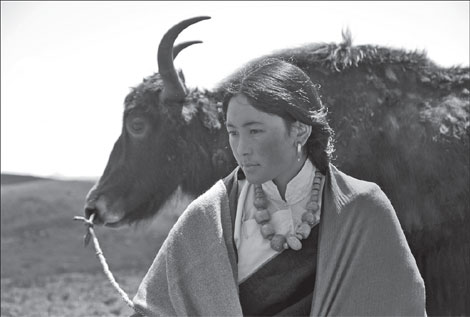
Norlha collections capitalize on the quality yak wool used in traditional Tibetan hand-sewn jackets and robes. [Photo/China Daily]
A Gansu nomad finds a new calling in fashion design, with a little help from some long-haired friends.
Twenty-six-year-old Dorjee Rinchen came from a small village in Gannan Tibet Autonomous Prefecture, Gansu province. His most vivid memories are his childhood freedom and happiness. The sharp cliffs, deep caves and endless surrounding fields - everything in the small nomadic village molded him.
As his parents are Tibetan nomads, Rinchen started as a nomad, he says, at his parents' behest.
However, he insisted on going to school and later had the life-changing experience of becoming a fashion designer.
On Sunday, he will bring his works and tells his transforming story to Beijing's fashion fans, unveiling how his design has been influenced by the mysterious Tibetan culture and the high plateau.
"As a young child I always wanted to learn and see the world. I wanted to achieve something beyond the challenge of bringing sheep safely home at the end of day," he says.
He eventually tore himself away from life as a nomad and entered an alternative school in Qinghai. Upon graduation, one of his most revered professors suggested that he tried working in a yak-wool textile project being set up in the teacher's hometown, Zorge Ritoma, a small village deep in Amdo nomad county, in Gansu.
Having no idea about fashion and design, he left in 2008 to join the project, a factory called Norlha workshop, which creates products from the spinning and weaving of khullu, the precious fiber that insulates yaks from the harsh winter.
"I simply hoped to get a job after graduation," he says.
Norlha means "wealth of the Gods". Millions of yaks roam the high altitude pastures providing the nomads with all their needs, including the black braided tents, yak butter and casein, a protein concentrated in yak milk.
Rinchen started out managing Norlha's inventory, which enhanced his computer skills and also allowed him to learn the different textiles and their names. Eventually he began to be able to tell the different characteristics of the threads used.
Soon he took charge of the sampling section where people worked on samples from world-renowned designers for large fashion houses as well as in-house designers.
